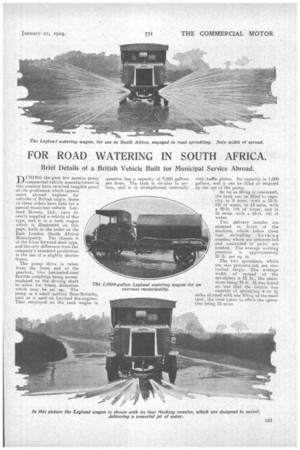FOR ROAD WATERING IN SOUTH AFRICA.
Page 15

If you've noticed an error in this article please click here to report it so we can fix it.
Brief Details of a British Vehicle Built for Municipal Service Abroad.
DTJRING the past few months many commercial-vehicle manufacturers in this country have received tangible proof of the preference which certain user § abroad express for vehicles of British origin. Some of these orders have been for a special municipal vehicle. Leyland Motors, Ltd., have recently supplied a vehicle of this type, and it is a tank wagon which is illustrated on this Page, built to the order of the East London (South Africa) Municipality. The chassis is of the 5-ton forward-dash type, and the only difference from the company's standard production is the use of a slightly shorter frame.
The pump drive is taken from the front. end of the gearbox, two laminated-steel flexible couplings being accommodated on the driving shaft to allow for frame distortion which may be set up. The pump is a small pattern Rees-Roturbo, such as is used on Leyland fire-engines. That employed on the tank wagon in question has a capacity of • 7,000 gallons per hour. The tank is circular in section, and it is strengthened internally with baffle plates. Its capacity Is 1,000 gallons, and it can be filled or emptied by the use of the pump. So far as filling is concerned, the tank can be filled to capacity in 9 mins. with a. 13-ft. lift of water, in 13 mins, with a 20-ft. lift of water, and in 16 mins, with a 25-ft. lift of water.
Two delivery nozzles are situated in front of the machine, whilst below them four swivelling flushing nozzles, which are pressure-fed and controlled in pairs; are located. The average working pressure is approximately 30 lb. per sq. in.
The two sprinklers, which are also pressure-fed, are controlled singly. The average width of spread of the sprinklers is 55 ft., the maximum being 70 ft. It was found on test that the vehicle was capable of sprinkling 4 to 41 miles of road with one filling of the main tank, the time taken to effect the operation being 25 wins.




























